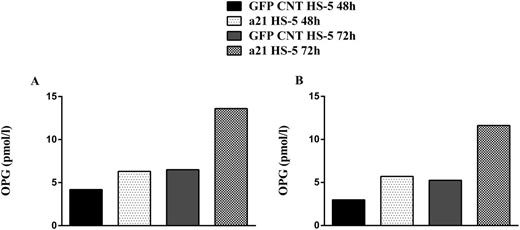Abstract
Multiple Myeloma (MM)-related osteolytic lesions of the skeleton result from asynchronous bone turnover wherein increased bone resorption by osteoclasts (OCLs) is associated to suppression of bone formation due to inhibition of osteoblasts (OBLs). In this context, the balance between osteoprotegerin (OPG) and the receptor activator for nuclear factor-κB ligand (RANKL) plays a relevant role, because RANKL signaling induces differentiation, activation and survival of OCLs, whereas OPG acts as a decoy receptor of RANKL, thus blocking bone resorption. In the MM milieu, the interaction of malignant plasma cells (PCs) and bone marrow stromal cells (BMSCs) favors the production of RANKL and reduces OPG secretion by BMSCs. The resulting severe imbalance in RANKL/OPG ratio is the main trigger of MM-related bone disease (BD). Emerging evidence indicates that microRNAs (miRNAs) play a crucial role in bone remodelling as they can act on bone effectors (OCLs, OBLs, BMSCs) and PCs. Indeed, several findings suggest that miR-29 family support OBL differentiation, while we have previously demonstrated that miR-29b is down-regulated during osteoclastogenesis and its enforced expression functionally inhibits terminally differentiated OCLs. Moreover, also miR-21 plays an important role in OCL differentiation and is up-regulated by IL-6 via STAT3 that, in turn, promotes survival and proliferation of PCs, favoring bone damage. On these bases, we investigated whether modulation of miR-21 expression in BMSCs may have an impact on MM microenviroment, focusing our attention on OPG production, taking into account that different bioinformatics resources indicate OPG mRNA as a predicted target of miR-21. To this end, we established a co-culture system where primary BMSCs and HS-5, a human BMSC cell line, were exposed to either RPMI 8226 MM cells or primary CD138+ PCs isolated from MM patients. Then, we isolated BMSCs and evaluated miR-21 and OPG expression. We observed strong up-regulation of miR-21 in BMSCs and HS-5 together with a significant reduction of OPG levels in the presence of MM cells. These preliminary data suggested that antagonizing miR-21 in BMSCs exposed to MM cells could restore RANKL/OPG ratio through the up-regulation of OPG. To address this hypothesis, we transduced HS-5 cell line with a lentiviral vector carrying anti-miR-21 sequence (a21 HS-5) or with an empty lentiviral vector carrying only the GFP gene (GFP CNT HS-5). OPG expression was determined by RT-PCR, Western Blotting and ELISA assays after 48h and 72h of exposure to RPMI 8226 cells or primary PCs. We observed a significant increase in OPG production in a21 HS-5 cells compared to controls (Fig. 1, panel A and panel B). We also evaluated RANKL expression in the same samples. Interestingly, constitutive inhibition of miR-21 in HS-5 cell line upon exposure to MM cells induced a significant RANKL down-regulation, thus restoring a physiological RANKL/OPG ratio.
We hypothesized that this surprising result may be due to the activity of the protein inhibitor of activated STAT3 (PIAS3). Indeed, PIAS3 binds to STAT3 and blocks its DNA binding ability, thereby inhibiting STAT3-mediated gene activation. It is already known that PIAS3 acts as a negative regulator of the RANKL expression and it is a direct and validated target of miR-21. Therefore, the inhibition of miR-21 induces PIAS3 up-regulation and a decreased RANKL transcription. To confirm the involvement of PIAS3 in RANKL suppression in our system, we performed a WB assay, showing that in a21 HS-5 cells, PIAS3 is indeed over-expressed compared to controls. Taken together, these findings provide the first evidence that inhibition of miR-21 in MM microenviroment restores RANKL/OPG balance, which might result in prevention of skeletal- related events. These findings support the design of innovative miR-21 inhibition-based approaches against MM-related BD.
No relevant conflicts of interest to declare.
Author notes
Asterisk with author names denotes non-ASH members.


This feature is available to Subscribers Only
Sign In or Create an Account Close Modal